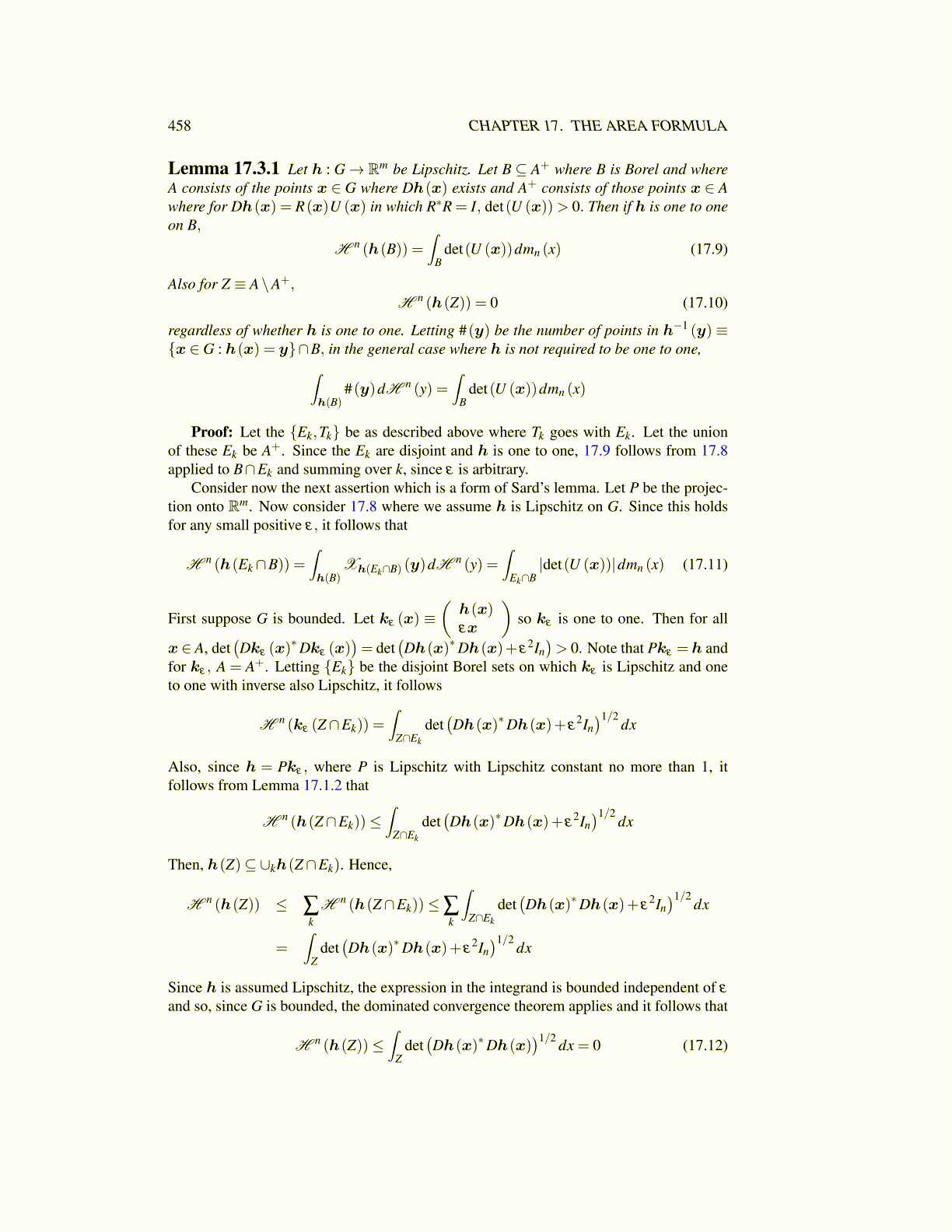
458 CHAPTER 17. THE AREA FORMULA
Lemma 17.3.1 Let h : G→ Rm be Lipschitz. Let B ⊆ A+ where B is Borel and whereA consists of the points x ∈ G where Dh(x) exists and A+ consists of those points x ∈ Awhere for Dh(x) = R(x)U (x) in which R∗R = I, det(U (x))> 0. Then if h is one to oneon B,
H n (h(B)) =∫
Bdet(U (x))dmn (x) (17.9)
Also for Z ≡ A\A+,H n (h(Z)) = 0 (17.10)
regardless of whether h is one to one. Letting #(y) be the number of points in h−1 (y) ≡{x ∈ G : h(x) = y}∩B, in the general case where h is not required to be one to one,∫
h(B)#(y)dH n (y) =
∫B
det(U (x))dmn (x)
Proof: Let the {Ek,Tk} be as described above where Tk goes with Ek. Let the unionof these Ek be A+. Since the Ek are disjoint and h is one to one, 17.9 follows from 17.8applied to B∩Ek and summing over k, since ε is arbitrary.
Consider now the next assertion which is a form of Sard’s lemma. Let P be the projec-tion onto Rm. Now consider 17.8 where we assume h is Lipschitz on G. Since this holdsfor any small positive ε, it follows that
H n (h(Ek ∩B)) =∫h(B)
Xh(Ek∩B) (y)dH n (y) =∫
Ek∩B|det(U (x))|dmn (x) (17.11)
First suppose G is bounded. Let kε (x) ≡(h(x)εx
)so kε is one to one. Then for all
x ∈ A, det(Dkε (x)
∗Dkε (x))= det
(Dh(x)∗Dh(x)+ ε2In
)> 0. Note that Pkε = h and
for kε , A = A+. Letting {Ek} be the disjoint Borel sets on which kε is Lipschitz and oneto one with inverse also Lipschitz, it follows
H n (kε (Z∩Ek)) =∫
Z∩Ek
det(Dh(x)∗Dh(x)+ ε
2In)1/2
dx
Also, since h = Pkε , where P is Lipschitz with Lipschitz constant no more than 1, itfollows from Lemma 17.1.2 that
H n (h(Z∩Ek))≤∫
Z∩Ek
det(Dh(x)∗Dh(x)+ ε
2In)1/2
dx
Then, h(Z)⊆ ∪kh(Z∩Ek). Hence,
H n (h(Z)) ≤ ∑k
H n (h(Z∩Ek))≤∑k
∫Z∩Ek
det(Dh(x)∗Dh(x)+ ε
2In)1/2
dx
=∫
Zdet(Dh(x)∗Dh(x)+ ε
2In)1/2
dx
Since h is assumed Lipschitz, the expression in the integrand is bounded independent of ε
and so, since G is bounded, the dominated convergence theorem applies and it follows that
H n (h(Z))≤∫
Zdet(Dh(x)∗Dh(x)
)1/2 dx = 0 (17.12)